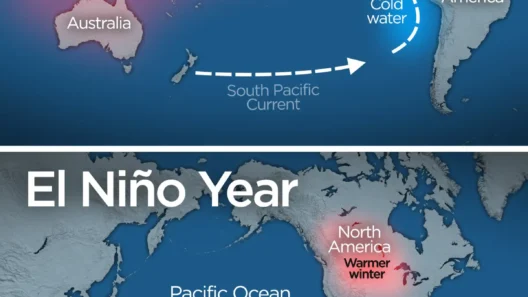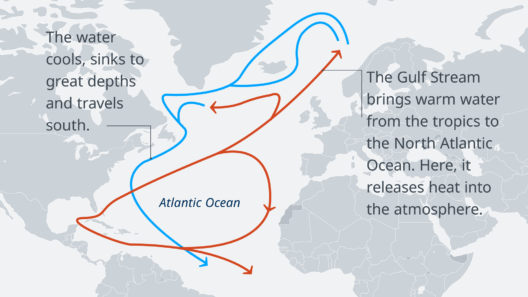The Earth’s climate, a labyrinthine web of intricate interactions, is predominantly governed by forces hidden from immediate view. Among the most profound of these forces are the ocean currents, often described as the planet’s “hidden conveyor belts.” These currents, akin to colossal rivers flowing beneath the sea’s surface, play a pivotal role in regulating temperatures, weather patterns, and ultimately, the habitability of various regions across the globe.
To fathom the enormity of these currents, one must first envision the ocean as a vast, dynamic entity, where temperatures and salinity converge to orchestrate a grand ballet of movement. The primary driving force behind these currents is solar energy. The sun’s rays strike the Earth unevenly due to its spherical shape—this differential heating creates zones of varying temperatures. Warm water, buoyant and light, rises and flows toward colder regions, initiating a natural flow that is perpetuated by the Earth’s rotation and wind patterns.
Imagine for a moment the Gulf Stream, a robust current that emerges from the warm waters of the Gulf of Mexico. This current then meanders across the Atlantic Ocean, releasing its heat into the atmosphere of Western Europe. The result? A temperate climate in areas that would otherwise experience stark cold, akin to a warm embrace in the midst of winter. This phenomenon exemplifies the intrinsic relationship between ocean currents and regional climates. It underscores how vital these currents are, acting as conduits of warmth and moisture that can invigorate or devastate ecosystems.
Yet, the Gulf Stream is merely one thread in the expansive tapestry of ocean currents. The ocean’s circulation system consists of a myriad of currents, interlinked in a continuous loop known as the thermohaline circulation. This “global conveyor belt” consists of both surface and deep-water currents, driving the movement of water globally. The term “thermohaline” refers to the temperature (thermo) and salinity (haline) gradients that dictate water density, influencing its motion. In a world where the poles are freezing and the tropics are boiling, the ocean currents serve as an equalizer, distributing heat and regulating climate in a delicate balance.
As the currents descend and ascend, they also play an instrumental role in nutrient cycling. Upwelling zones, where deep, nutrient-rich water rises to the surface, are productive marine ecosystems teeming with life. This provides sustenance for myriad fish species and supports a robust fishing industry. Coastal communities across the globe rely on these currents for their very livelihoods. Here, the ocean currents transform into not just regulators of climate but as lifelines for humanity.
Moreover, these currents are not static; they are dynamic and susceptible to various changes, particularly those induced by climate change. The warming of the Earth’s atmosphere leads to melting polar ice, contributing freshwater to the oceans and disrupting the salinity levels that are crucial for maintaining the current flow. Any significant alteration in this conveyor belt can initiate a cascade of climatic events. For instance, a slowdown in the Gulf Stream could herald disastrous changes, including more extreme weather conditions, sea-level rise, and altered precipitation patterns.
Additionally, the interaction between ocean currents and atmospheric circulation is profound and multifaceted. The ocean acts as a vast reservoir of heat, influencing weather systems far beyond its surface. El Niño and La Niña phenomena, characterized by unusual sea surface temperatures in the Pacific Ocean, are direct manifestations of this interaction. These phenomena can lead to widespread climatic ramifications, affecting everything from monsoon patterns in South Asia to droughts in Australia. The ocean currents, therefore, are not merely passive channels; they are active participants in the Earth’s climatic narrative.
As we delve deeper into the role of ocean currents, it becomes evident that their influence extends to biodiversity. Marine species rely heavily on these currents for migration, spawning, and feeding. The alteration of current patterns can disrupt these critical life processes, leading to a decline in species populations and a shift in marine biodiversity. Coral reefs, known as the “rainforests of the sea,” are particularly vulnerable. Stress from changing water temperatures and currents can result in coral bleaching, a phenomenon that jeopardizes entire ecosystems.
In conclusion, the hidden conveyor belts of the ocean—its currents—are vital to understanding Earth’s climate system. They regulate temperatures and weather patterns, support marine life, and influence human activities. As the planet continues to warm, it becomes imperative to protect and study these ecological marvels. Without concerted global efforts to mitigate climate change, the delicate balance maintained by these currents could be irrevocably altered, leading to catastrophic consequences for our planet. The oceans, with their hidden currents, serve as a poignant reminder of the interconnectedness of life, climate, and the myriad forces at play in sustaining our world.






